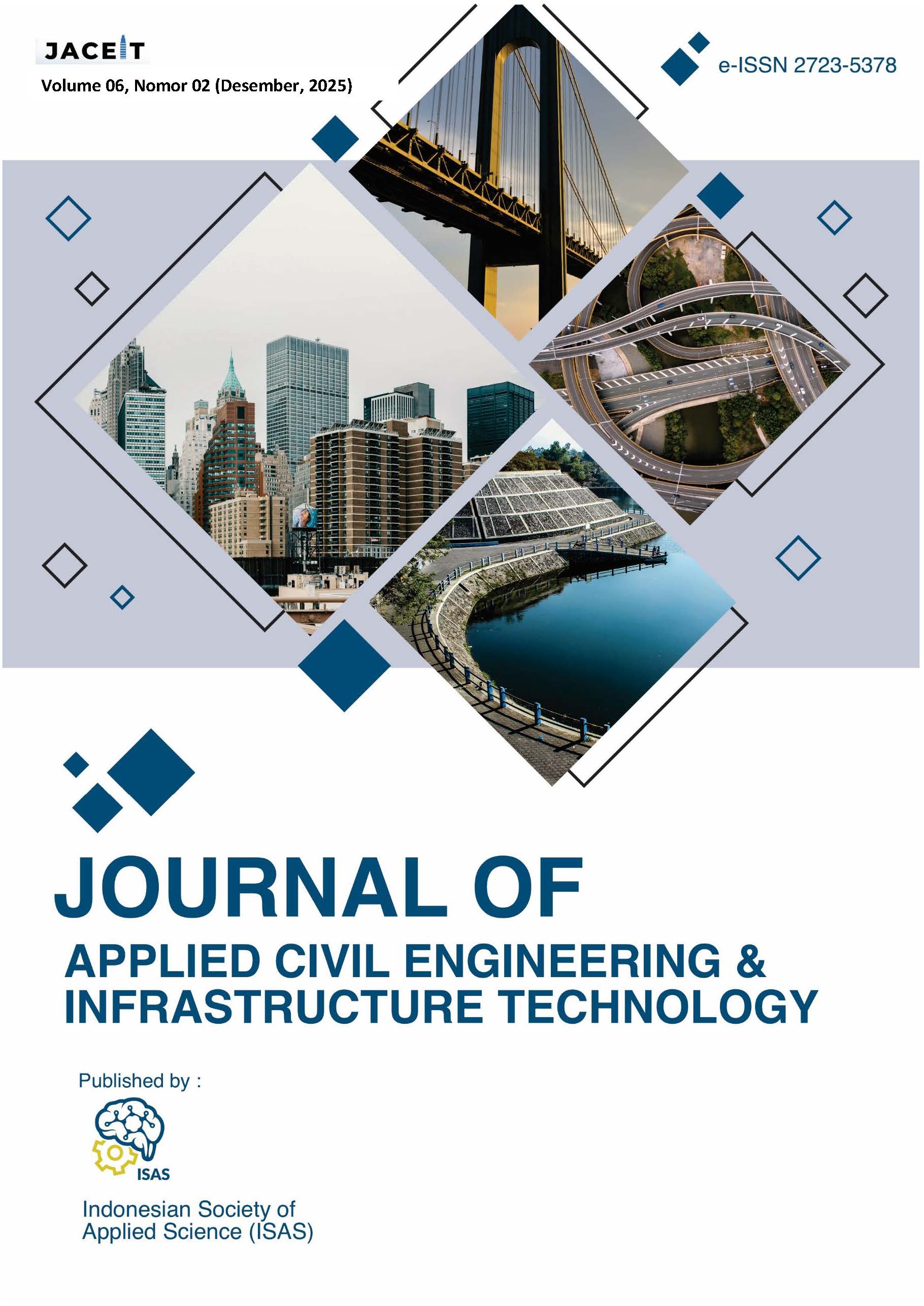Pengaruh Komposisi Limbah Botol Plastik Sebagai Material Paving Block Bermutu Tinggi
DOI:
https://doi.org/10.52158/jaceit.v6i2.1008Keywords:
Plastic Bottle Waste, Paving Block, Compressive Strength ValueAbstract
Plastic waste is a type of waste that is difficult to decompose by natural processes so other alternatives are needed in its processing such as paving block construction materials. This study aims to determine the effect of the characteristics of plastic bottle waste and determine the compressive strength value of paving blocks. The method used in the study was an experiment in the Civil Engineering Laboratory, Politeknik Negeri Fakfak with a mixture composition of 100% PS, 50 PS: 50% KK, 40% PS: 60% KK with a rectangular paving block design type measuring 20 cm x 10 cm x 8 cm. The results showed that using 50% plastic bottle waste and 50% gravel affected the characteristics and compressive strength value of paving blocks. The compressive strength value of Paving Blocks using 50% PS bottle waste and 50% gravel was higher than the mixture of 100% PS bottle waste and the mixture of 40% PS bottle waste + 60% KK, which were 24.14 MPa, 22.79 MPa, and 21.58 MPa. The mix of 50% plastic bottle waste and 50% gravel showed good performance in the paving quality category, including a mixture of 20% PET and 80% fly ash with a quality of 24.20 MPa for use in pedestrian or parking areas.
References
Artiani, G.P. Bahan konstruksi ramah lingkungan dengan pemanfaatan limbah botol plastik kemasan air mineral dan limbah kulit kerang hijau sebagai campuran paving block. Jurnal Konstruksia, 9. 2: 25-30. 2018.
Murdiyoto, A.R., Pemanfaatan limbah botol plastik jenis PET (poly-ethylene terephalate) untuk agregat kasar pembuatan paving block. TESIS MAGISTER, Program Studi Ilmu Material, Universitas Indonesia, Juli 2011.
Burhanuddin dkk. Pemanfaatan Limbah Plastik Bekas Untuk Bahan Utama Pembuatan Paving Block. Jurnal Rekayasa Lingkungan, 18.1. 2018.
Bakhtiar, A. Studi peningkatan mutu paving-block dengan penambahan abu sekam padi. Jurnal Portal, 1. 2: 73-80. 2009.
Sherliana, Studi kuat tekan paving block dengan campuran tanah, semen dan abu sekam padi menggunakan alat pemadat modifikasi. Jurnal Rekayasa Sipil dan Desain, 4. 1: 99-112. 2016.
Sudibyo, G.H, Haryanto, Y, Fatkhurrozak, F. Abu terbang (fly ash) sebagai bahan tambah untuk meningkatkan kuat tekan bata beton (paving block), Dinamika Rekayasa, 4. 2: 65-76. 2008.
Anggodo, A. Pengaruh penggunaan abu batu bara (fly ash) terhadap kuat tekan paving block. Jurnal Teknik Sipil dan Arsitektur, Vol. 4, No.1. 2014.
Luthfizar, G.Y, Puji, F.S, dan Akbari, T. Pemanfaatan limbah pasir silika sebagai bahan pengganti pasir untuk pembuatan paving block. JURNALIS, Vol. 2, No.1, Februari 2019.
Adilah, F. Pengaruh campuran silica fume sebagai pengganti sebagian semen dalam pembuatan paving block dengan metode tekanan. SKRIPSI-S1. Fakultas Teknik. Universitas Muhammadiyah Surakarta. 2020.
Harijanto, F.D, Kasiati, E, Wibowo, B, Arifin, S. Penambahan abu ampas tebu dan limbah boma bisma indra untuk pembuatan paving block. Jurnal Aplikasi, Vol.12, No.1, Februari 2014.
Widodo, s., marleni, n. N., & firdaus, n. A. Pelatihan pembuatan paving block dan eco-bricks dari limbah sampah plastik di kampung tulung kota magelang. Community empowerment vol.3 no.2. pp.63-66. 2018.
Rhoma, F. Pembuatan Paving Block Berbahan Dasar Limbah Plastik Polyethylene, Bottom Ash Hasil Isenerasi Dan Bahan Tambahan Pasir. Skripsi. Jurusan Kimia. Fakultas Matematika Dan Ilmu Pengetahuan Alam. Universitas Negeri Semarang. Semarang. 2020.
Mulyono, T. Teknologi Beton. Yogyakarta : Andi Offset. 2005.
SNI 03-0691-1996, Paving Blok. Badan Standardisasi Nasional Indonesia. 1996
Sudarno, Nicolaas S, Assa V. Pemanfaatan Limbah Plastik Untuk Pembuatan Paving Block. Jurnal Teknik Sipil Terapan (JTST), 3 (2), 101-110. 2021.
Karisma, Dwifi Aprillia, Fauzie Nursandah, and Fitry Rahmawaty. "Utilization of plastic bottle waste as material for making sustainable cement-less aesthetic paving blocks." INERSIA lnformasi dan Ekspose Hasil Riset Teknik Sipil dan Arsitektur 19.2: 261-270. 2023.
Astanto, Mireikel Marvel, Steve WM Supit, and Jeanely Rangkang. "Kuat Tekan Dan Kuat Lentur Paving Block Berpori Menggunakan Limbah Botol Plastik Tipe Polyethylene Terephtalate." Prosiding Seminar Nasional Terapan Riset Inovatif (SENTRINOV). Vol. 8. No. 1. 2022.
Riyandini, Vina Lestari, Hendri Sawir, and Syukri Ilham. "Daur Ulang Limbah Plastik Polyethylene Terephthalate (PET) dan Abu Terbang (Fly Ash) Menjadi Paving Block." Journal of Applied Civil Engineering and Infrastructure Technology 5.1: 37-41. 2024.
Cahyani, Risti Indah, et al. "Paving Block Quality With Several Types of Plastic Waste on Compressive Strength." Madani: Jurnal Ilmiah Multidisiplin 1.12. 2023.
Hamid, Nor Baizura, et al. "Development of paving blocks using waste materials." Int. J. Innov. Technol. Explor. Eng 8: 1329-1335. 2019.
Arnandha, Y., A. Rakhmawati, and H. H. Ali. "Study of Utilizations of Recycled LDPE Plastic and Stone Ash Waste from Remaining Split Stone Fragments for Block Paving Application." Journal of Physics: Conference Series. Vol. 1625. No. 1. IOP Publishing, 2020.



